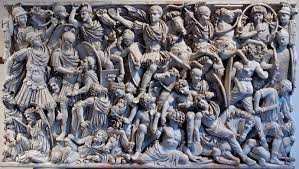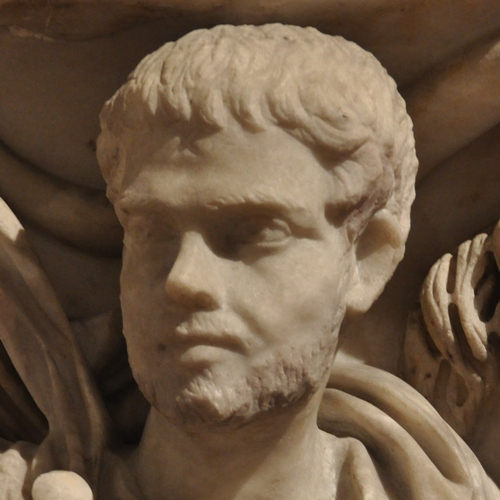Late Rome - Ludovisi Battle Sarcophagus - AP Art History (1 artwork) 🇮🇹
Ludovisi Battle Sarcophagus

Date: 250 CE
Period/style: Late Rome
Artist/Architect: N/A
Patron: N/A
Original Location: Rome
materials/techniques: tumultuous, crowded composition, marble, ^^high-relief^^
Form: marble, crowded composition, ^^tumult (chaotic scene),^^ high-relief.
Function: ^^vessel to hold ashes (^^^^sarcophagus^^^^)^^,
high-relief depicts battle scene (last battle of Rome).
Content: crowded composition. Romans and Germans are battling as depicted in the high-relief; ^^Romans are depicted to have a helmet, shaven -^^ ^^Germans^^ ^^are depicted with beards to appear barbaric.^^
- ^^main character of this sarcophagus’^^ ^^high-relief^^ ^^is^^ ^^Hostilian^^^^.^^
- Hostilian is depicted as a god; no weapons or armor demonstrates invincibility.
Context: production of sarcophagi has stopped due to Rome transitioning into a new religion; Christianity.
- Romans have stopped cremation due to the Christian belief that Jesus rose from the dead.
Description:
The significance of the Ludovisi Battle Sarcophagus is important, as it showed a transition of religion of the Romans, where they converted to Christianity. The Ludovisi Battle Sarcophagus is one of the last sarcophagus made due to the Christian belief where Jesus rose from the dead. Furthermore, the tumult narrative of this sarcophagus shows that the main character of this artwork is Hostillian, an emperor who is depicted as a god as indicated by not having a helmet, beard, or weapon, and defeating the Germans with the Roman soldiers.The Germans were depicted as barbarians by the Romans as they give them a style change by adding a beard to contrast them from the clean shaven Romans.
Emperor Hostilian
